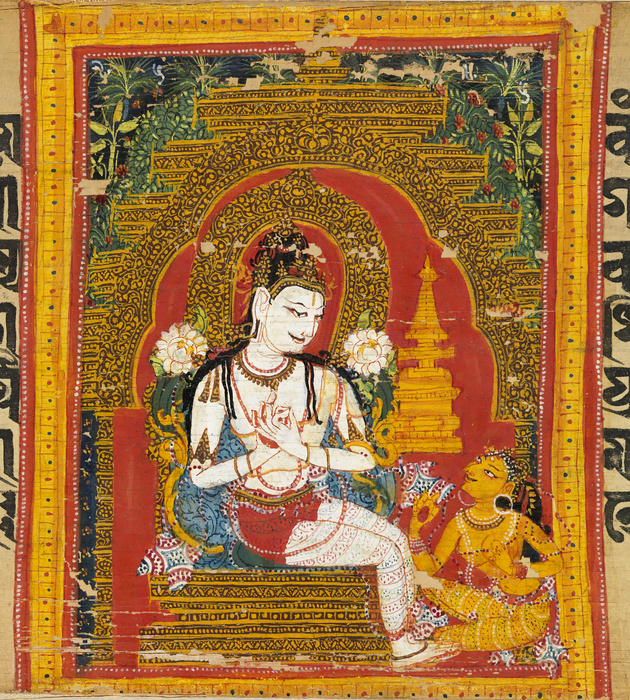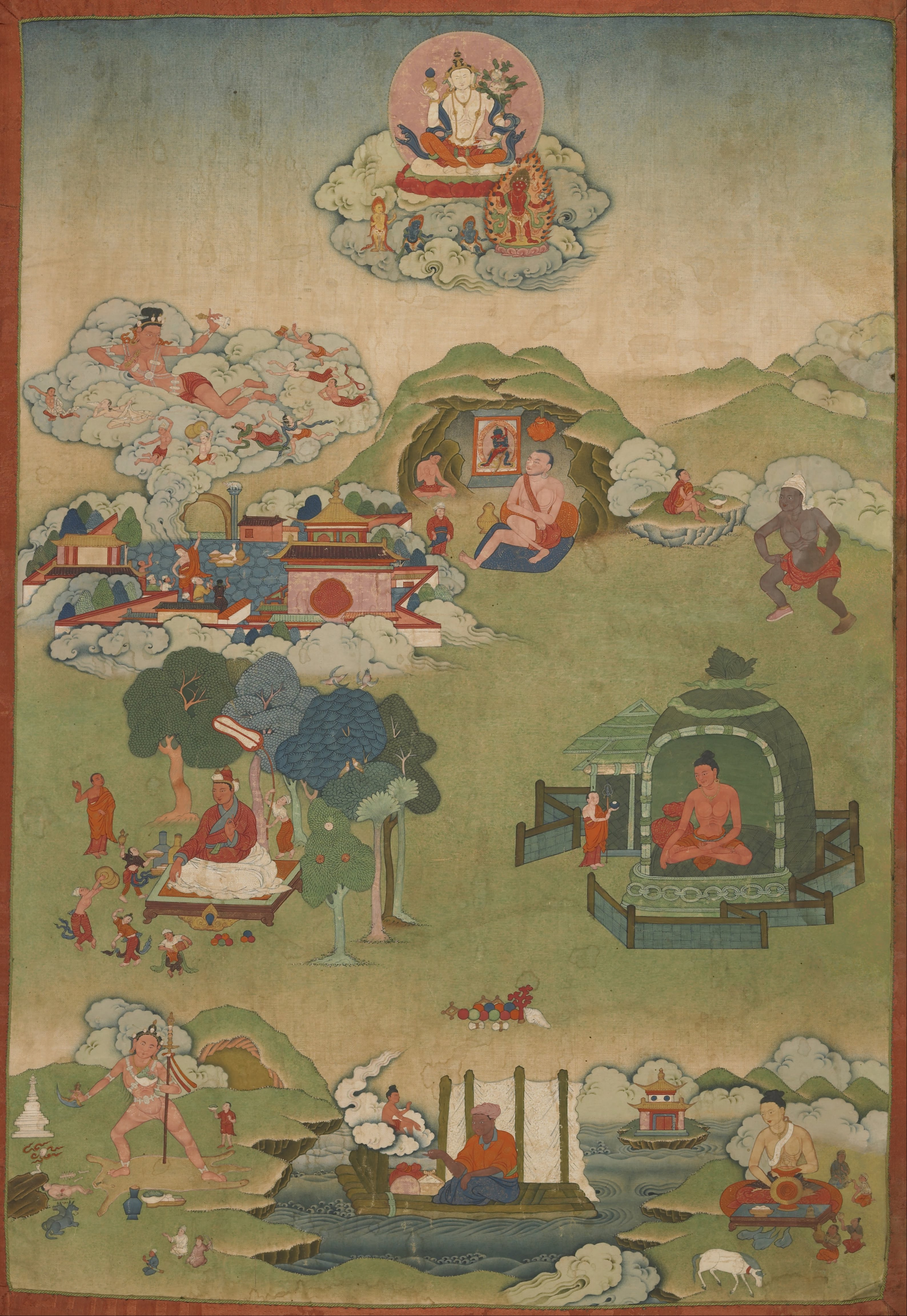|
Upaya
In Buddhism, upaya (Sanskrit: उपाय, , ''expedient means'', ''pedagogy'') is an aspect of guidance along the Buddhist paths to liberation where a conscious, voluntary action "is driven by an incomplete reasoning" about its direction. Upaya is often used with ''kaushalya'' (कौशल्य, "cleverness"), ''upaya-kaushalya'' meaning "skill in means". Upaya-kaushalya is a concept emphasizing that practitioners may use their own specific methods or techniques that fit the situation in order to gain enlightenment. The implication is that even if a technique, view, etc., is not ultimately "true" in the highest sense, it may still be an ''expedient'' practice to perform or view to hold; i.e., it may bring the practitioner closer to the true realization in a similar way. The exercise of skill to which it refers, the ability to adapt one's message to the audience, is of enormous importance in the Pali Canon. The Digital Dictionary of Buddhism notes that rendering the Chine ... [...More Info...] [...Related Items...] OR: [Wikipedia] [Google] [Baidu] |
Mahayana
Mahāyāna ( ; , , ; ) is a term for a broad group of Buddhist traditions, Buddhist texts#Mahāyāna texts, texts, Buddhist philosophy, philosophies, and practices developed in ancient India ( onwards). It is considered one of the three main existing branches of Buddhism, the others being Theravāda and Vajrayāna.Harvey (2013), p. 189. Mahāyāna accepts the main scriptures and teachings of Early Buddhist schools, early Buddhism but also recognizes various doctrines and texts that are not accepted by Theravada Buddhism as original. These include the Mahāyāna sūtras and their emphasis on the ''bodhisattva'' path and Prajnaparamita, ''Prajñāpāramitā''. Vajrayāna or Mantra traditions are a subset of Mahāyāna which makes use of numerous Tantra, tantric methods Vajrayānists consider to help achieve Buddhahood. Mahāyāna also refers to the path of the bodhisattva striving to become a fully awakened Buddha for the benefit of all sentience, sentient beings, and is thus also ... [...More Info...] [...Related Items...] OR: [Wikipedia] [Google] [Baidu] |
Arthashastra
''Kautilya's Arthashastra'' (, ; ) is an Ancient Indian Sanskrit treatise on statecraft, politics, economic policy and military strategy. The text is likely the work of several authors over centuries, starting as a compilation of ''Arthashastras'', texts which according to Olivelle date from the 2nd c. BCE to the 1st c. CE. These treatises were compiled and amended in a new treatise, according to McClish and Olivelle in the 1st century CE by either an anonymous author or Kautilya, though earlier and later dates have also been proposed. While often regarded as created by a single author, McClish and Olivelle argue that this compilation, possibly titled ''Daņdanīti'', served as the basis for a major expansion and redaction in the 2nd or 3rd century CE by either Kautilya or an anonymous author, when several books, dialogical comments, and the disharmonious chapter-division were added, and a stronger Brahmanical ideology was brought in. The text thus became a proper ''arthashast ... [...More Info...] [...Related Items...] OR: [Wikipedia] [Google] [Baidu] |
Lotus Sutra
The ''Lotus Sūtra'' (Sanskrit: ''Saddharma Puṇḍarīka Sūtram'', ''Sūtra on the White Lotus of the True Dharma'', zh, p=Fǎhuá jīng, l=Dharma Flower Sutra) is one of the most influential and venerated Buddhist Mahāyāna sūtras. It is the main scripture on which the Tiantai along with its derivative schools, the Japanese Tendai and Nichiren, Korean Cheontae, and Vietnamese Thiên Thai schools of Buddhism were established. It is also influential for other East Asian Buddhist schools, such as Zen. According to the British Buddhologist Paul Williams, "For many Buddhists in East Asia since early times, the ''Lotus Sūtra'' contains the final teaching of Shakyamuni Buddha—complete and sufficient for salvation." The American Buddhologist Donald S. Lopez Jr. writes that the ''Lotus Sūtra'' "is arguably the most famous of all Buddhist texts," presenting "a radical re-vision of both the Buddhist path and of the person of the Buddha." Two central teachings ... [...More Info...] [...Related Items...] OR: [Wikipedia] [Google] [Baidu] |
Yana (Buddhism)
Yāna (Sanskrit: यान and Pāli: "vehicle") refers to a mode or method of spiritual practice in Buddhism. It is claimed they were all taught by the Buddha, Gautama Buddha in response to the various capacities of individuals. On an outwardly conventional level, the teachings and practices may appear contradictory, but ultimately they all have the same goal. Nomenclature, etymology and orthography In form, yāna is a neuter noun derived from the Sanskrit root yā- meaning to "go to" or "move" or "reach". The suffix employed to form this noun may have different values: while primarily yāna is understood to refer to the means (kara.na) through which one goes to/ reaches a location, it may technically also refer to the action itself (bhāva). Yāna is therefore primarily a "vehicle", in most contexts relevant to the Buddhist doctrine of three yānas. "Vehicle" is often used as a preferred translation as the word that provides the least in the way of presuppositions about the m ... [...More Info...] [...Related Items...] OR: [Wikipedia] [Google] [Baidu] |
Classification Of Buddha's Teaching
Buddhist Doctrinal Classification refers to various systems used by Mahāyāna Buddhist traditions to classify and organize the numerous texts and teachings that have developed over the history of Buddhism. According to buddhologist Peter Gregory, these classification systems fulfill three interwoven roles for Buddhist traditions: hermeneutical, sectarian, and soteriological. From an hermeneutical standpoint, they function as a method of organizing Buddhist texts both chronologically and hierarchically, thereby producing a doctrinal structure that is internally coherent and logically consistent. In its sectarian application, different Buddhist schools evaluate and order scriptures based on their own doctrinal priorities, using this to legitimize their specific traditions. From a soteriological perspective, classification schemas map out a graded path of spiritual development, wherein the practitioner’s insight evolves from basic teachings toward the most advanced and profound r ... [...More Info...] [...Related Items...] OR: [Wikipedia] [Google] [Baidu] |
Hermeneutic
Hermeneutics () is the theory and methodology of interpretation, especially the interpretation of biblical texts, wisdom literature, and philosophical texts. As necessary, hermeneutics may include the art of understanding and communication. Modern hermeneutics includes both verbal and non-verbal communication,''The Routledge Companion to Philosophy in Organization Studies'', Routledge, 2015p. 113Joann McNamara, ''From Dance to Text and Back to Dance: A Hermeneutics of Dance Interpretive Discourse'', PhD thesis, Texas Woman's University, 1994. as well as semiotics, presuppositions, and pre-understandings. Hermeneutics has been broadly applied in the humanities, especially in law, history and theology. Hermeneutics was initially applied to the interpretation, or exegesis, of scripture, and has been later broadened to questions of general interpretation. p. 2 The terms ''hermeneutics'' and ''exegesis'' are sometimes used interchangeably. Hermeneutics is a wider discipline wh ... [...More Info...] [...Related Items...] OR: [Wikipedia] [Google] [Baidu] |
Gautama Buddha
Siddhartha Gautama, most commonly referred to as the Buddha (),* * * was a śramaṇa, wandering ascetic and religious teacher who lived in South Asia during the 6th or 5th century BCE and founded Buddhism. According to Buddhist legends, he was born in Lumbini, in what is now Nepal, to royal parents of the Shakya clan, but Great Renunciation, renounced his Householder (Buddhism), home life to live as a wandering ascetic. After leading a life of mendicancy, asceticism, and meditation, he attained Nirvana (Buddhism), nirvana at Bodh Gaya, Bodh Gayā in what is now India. The Buddha then wandered through the lower Indo-Gangetic Plain, teaching and building a Sangha, monastic order. Buddhist tradition holds he died in Kushinagar and reached ''parinirvana'' ("final release from conditioned existence"). According to Buddhist tradition, the Buddha taught a Middle Way between sensual indulgence and severe asceticism, leading to Vimutti, freedom from Avidyā (Buddhism), ignora ... [...More Info...] [...Related Items...] OR: [Wikipedia] [Google] [Baidu] |
Bodhisattva
In Buddhism, a bodhisattva is a person who has attained, or is striving towards, '' bodhi'' ('awakening', 'enlightenment') or Buddhahood. Often, the term specifically refers to a person who forgoes or delays personal nirvana or ''bodhi'' in order to compassionately help other individuals reach Buddhahood. In the Early Buddhist schools, as well as modern Theravāda Buddhism, bodhisattva (or bodhisatta) refers to someone who has made a resolution to become a Buddha and has also received a confirmation or prediction from a living Buddha that this will come to pass. In Theravāda Buddhism, the bodhisattva is mainly seen as an exceptional and rare individual. Only a few select individuals are ultimately able to become bodhisattvas, such as Maitreya. In Mahāyāna Buddhism, a bodhisattva refers to anyone who has generated '' bodhicitta'', a spontaneous wish and compassionate mind to attain Buddhahood for the benefit of all sentient beings. Mahayana bodhisattvas are spiritua ... [...More Info...] [...Related Items...] OR: [Wikipedia] [Google] [Baidu] |
Victor Mair
The name Victor or Viktor may refer to: * Victor (name), including a list of people with the given name, mononym, or surname Arts and entertainment Film * ''Victor'' (1951 film), a French drama film * ''Victor'' (1993 film), a French short film * ''Victor'' (2008 film), a TV film about Canadian swimmer Victor Davis * ''Victor'' (2009 film), a French comedy * ''Victor'', a 2017 film about Victor Torres by Brandon Dickerson * ''Viktor'' (2014 film), a Franco/Russian film * ''Viktor'' (2024 film), a documentary of a deaf person's perspective during Russian invasion of Ukraine Music * ''Victor'' (Alex Lifeson album), a 1996 album by Alex Lifeson * ''Victor'' (Vic Mensa album), 2023 album by Vic Mensa * "Victor", a song from the 1979 album ''Eat to the Beat'' by Blondie Businesses * Victor Talking Machine Company, early 20th century American recording company, forerunner of RCA Records * Victor Company of Japan, usually known as JVC, a Japanese electronics corporatio ... [...More Info...] [...Related Items...] OR: [Wikipedia] [Google] [Baidu] |
Mahasiddha
Mahasiddha (Sanskrit: ''mahāsiddha'' "great adept; ) is a term for someone who embodies and cultivates the "siddhi of perfection". A siddha is an individual who, through the practice of sādhanā, attains the realization of siddhis, psychic and spiritual abilities and powers. Mahasiddhas were practitioners of yoga and tantra, or ''tantrika''s. Their historical influence throughout the Indian subcontinent and the Himalayas was vast and they reached mythic proportions as codified in their songs of realization and hagiography, hagiographies, or Namtar (biography), namtars, many of which have been preserved in the Tibetan Buddhist canon. The Mahasiddhas are identified as founders of Vajrayana traditions and lineage (Buddhism), lineages such as Dzogchen and Mahamudra, as well as among Bon, Bön, Nath, Nāth, and Tamil Siddhar, siddhars, with the same Mahasiddha sometimes serving simultaneously as a founding figure for different traditions. Robert Thurman explains the symbiotic relati ... [...More Info...] [...Related Items...] OR: [Wikipedia] [Google] [Baidu] |
Sanskrit
Sanskrit (; stem form ; nominal singular , ,) is a classical language belonging to the Indo-Aryan languages, Indo-Aryan branch of the Indo-European languages. It arose in northwest South Asia after its predecessor languages had Trans-cultural diffusion, diffused there from the northwest in the late Bronze Age#South Asia, Bronze Age. Sanskrit is the sacred language of Hinduism, the language of classical Hindu philosophy, and of historical texts of Buddhism and Jainism. It was a lingua franca, link language in ancient and medieval South Asia, and upon transmission of Hindu and Buddhist culture to Southeast Asia, East Asia and Central Asia in the early medieval era, it became a language of religion and high culture, and of the political elites in some of these regions. As a result, Sanskrit had a lasting effect on the languages of South Asia, Southeast Asia and East Asia, especially in their formal and learned vocabularies. Sanskrit generally connotes several Indo-Aryan languages# ... [...More Info...] [...Related Items...] OR: [Wikipedia] [Google] [Baidu] |







